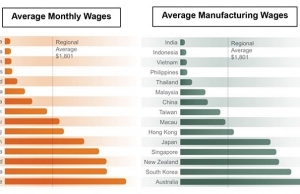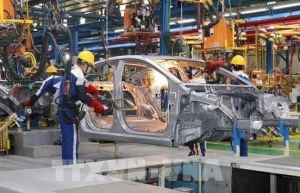Skilled labour force needed for agriculture sector
The agricultural sector is a pillar of Vietnam's economic growth. In 2022, agricultural export turnover reached more than $53 billion for the first time, accounting for more than 75 per cent of the total export value of the country. Eight product groups with export turnover of more than $2 billion including coffee, rubber, rice, vegetables, cashews, shrimp, basa fish, and wood products.
 |
| Minister of Agriculture and Rural Development, Le Minh Hoan |
To maintain this role as the backbone of the economy, there is still a lot of work to be done to modernise agriculture, especially regarding human resource development. Vocational training is currently a bottleneck in the sustainable development of the country's agriculture.
Although trained employees have increased rapidly, bringing the rate of qualified workers to 24 per cent, most receive short-term training, and the percentage of workers with degrees and certificates from the elementary level or above is low, at less than 5 per cent.
Between 2016-2020, the number of students registered to study agriculture, forestry, irrigation, and fisheries decreased by more than 30 per cent compared to the previous five years.
Labour in the agriculture, forestry, and fishery sectors currently accounts for 30 per cent of the total number of employees across the country, but students enrolled in these departments were less than 2 per cent of the approximately 520,000 students attending universities in 2022. Some traditional agricultural areas have enrolled few or even no new students recently.
This directly affects the quality of the industry's human resources in many aspects, from state management, production, and business, to research, application, and transfer of sci-tech.
The situation poses challenges to realising the goal of industrialisation and modernisation of the agricultural sector and rural development towards ecological agriculture, modern rural areas, and civilised farmers.
To overcome the above shortcomings and prepare human resources for implementing Resolution No.19-NQ/TW and the Strategy for Sustainable Agriculture and Rural Development in this decade, with a vision to 2050, the Party Personnel Committee of the Ministry of Agriculture and Rural Development issued Resolution No.37 in May. This should help innovate and improve the effectiveness of training high-quality human resources for the sustainable development of the sector before 2030.
The goals of the resolution clearly state that training high-quality human resources is needed to meet the quantity and quality requirements to build an ecological agriculture sector in a vibrant countryside, with innovative farmers forming a team of professional, knowledgeable, and skilled agricultural professionals to become a catalyst for rural economic development by 2030.
To achieve these goals, it is necessary to have the attention and leadership of the Party and state, and the support of ministries, central agencies, and localities, especially collaboration between vocational training facilities, and the business community.
Training institutions need to invest in and upgrade facilities and equipment for teaching and learning, while renovating the recruitment, fostering, and development of lecturers and teachers. Universities should concentrate on enrolment promotion, expanding many new training disciplines, and meeting the needs of society and learners.
The business community should actively participate in training and providing scholarships to support learners, especially in agricultural industries that are difficult to enrol in.
Manufacturers also have opportunities to access new technology and knowledge from research activities and technology transfer from universities through state funding and support from international projects.
These efforts have made an essential contribution to increasing the trained labour force and accelerating the industrialisation and modernisation process. These advancements will build the foundations to ensure that Vietnam is among the top positions of the world's major agricultural exporters.
 | Answers required for skilled labour scarcity Vietnam is expected to continue suffering from shortages of high-skilled engineers due to a rise in local production. |
 | Businesses in dire need of skilled workers Vietnam’s labour market is in desperate need of high-qualified and skilled workers, experts have said. |
 | Meeting skilled workforce demand in manufacturing and processing industry Machine learning, AI, and automation are shaping the evolution of the manufacturing and processing industry, a bright spot of Vietnam's economic recovery prospects. Experts from ManpowerGroup Vietnam, Thailand, and Middle East and the Institute of Labor and Social Affairs, Ministry of Labour, Invalids and Social Affairs have gathered to discuss sustainable solutions for workforce supply in the field. |
 | Vietnam needs skilled workforce to become upper-middle-income economy by 2035: WB Vietnam will need a skilled workforce to transform itself into an upper-middle-income economy by 2035, the World Bank has suggested in its recently-released report named “Taking Stock: Educate to Grow”. |
What the stars mean:
★ Poor ★ ★ Promising ★★★ Good ★★★★ Very good ★★★★★ Exceptional
Related Contents
Latest News
More News
- First members of Danang International Finance Centre revealed (December 22, 2025 | 17:39)
- Human-centred governance seen as key to AI development (December 19, 2025 | 18:19)
- Top 10 notable events of Vietnam’s industry and trade sector in 2025 (December 19, 2025 | 14:00)
- Tungsten surges to 12-year high as world enters a new 'black gold' race (December 18, 2025 | 17:27)
- Vietnam’s coffee exports set new record despite price pressures (December 18, 2025 | 17:13)
- Garment and textile sector seeks new growth after volatile year (December 18, 2025 | 17:01)
- VinSpeed and Siemens strengthen cooperation for high-speed rail development (December 18, 2025 | 16:53)
- High-tech adoption for TH true MILK (December 18, 2025 | 13:39)
- Takeda supports health resilience amid climate change challenges (December 18, 2025 | 12:39)
- Mondelez Kinh Do - a chapter of purpose-led leadership in Vietnam (December 18, 2025 | 09:44)

 Tag:
Tag:






















 Mobile Version
Mobile Version